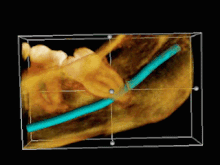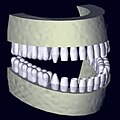Cone beam computed tomography
| Cone beam computed tomography | |
|---|---|
 Cone Beam CT scanner | |
| MeSH | D054894 |
Cone beam computed tomography (or CBCT, also referred to as C-arm CT, cone beam
CBCT has become increasingly important in treatment planning and diagnosis in
During dental/orthodontic imaging, the CBCT scanner rotates around the patient's head, obtaining up to nearly 600 distinct images. For interventional radiology, the patient is positioned offset to the table so that the region of interest is centered in the field of view for the cone beam. A single 200 degree rotation over the region of interest acquires a volumetric data set. The scanning software collects the data and reconstructs it, producing what is termed a digital volume composed of three-dimensional voxels of anatomical data that can then be manipulated and visualized with specialized software.[2][3] CBCT shares many similarities with traditional (fan beam) CT however there are important differences, particularly for reconstruction. CBCT has been described as the gold standard for imaging the oral and maxillofacial area.
History
Oral and maxillofacial radiology

In the late 1990s, Dr Yoshinori Arai in Japan and Dr Piero Mozzo in Italy independently developed Cone Beam Computed Technology for oral and maxillofacial radiology.[4] The first commercial system (the NewTom 9000) was introduced in the European market in 1996 and into the US market in 2001, by Italian company Quantitative Radiology.[2][5]
-
Axial image obtained from the first Cone-Beam 3D Scan performed on July 1, 1994[6]
-
Axial image obtained from the first Cone-Beam 3D Scan performed on July 1, 1994
-
Axial image obtained from the first Cone-Beam 3D Scan performed on July 1, 1994
-
Original notes about the first Cone-Beam 3D Scan performed on July 1, 1994
Radiotherapy
Cone beam CT using kilovoltage
Interventional radiology
While CBCT with X-ray image intensifiers was experimented with in the late 1990s, it was not until the adoption of flat-panel X-ray detectors, with improved contrast and spatial resolution, that CBCT became practical for clinical use in interventional radiology procedures.[10][11] Many fixed, and even mobile, C-arm fluoroscopy systems are now capable of CBCT acquisitions, in addition to traditional planar fluoroscopy.[12][13] CBCT aids image guidance during interventional radiology procedures treating various medical conditions including knee osteoarthritis, benign prostatic hyperplasia, and hepatocellular carcinoma.[14][15][16][17]
Applications
Endodontics

The most significant advantage of the CBCT in Endodontics is that it can show critical root canal anatomical features that conventional intraoral or panoramic images cannot.[18]
According to the American Association of Endodontics, there are numerous specific situations in which 3D images produced by CBCT enhance diagnosis and influence treatment, and its use cannot be disputed over conventional intraoral radiology based on ALARA principles.[19]
Implantology
A dental cone beam scan offers useful information when it comes to the assessment and planning of surgical implants. The American Academy of Oral and Maxillofacial Radiology (AAOMR) suggests cone-beam CT as the preferred method for presurgical assessment of dental implant sites.[20]
Orthodontics
As a 3D rendition, CBCT offers an undistorted view of the dentition that can be used to accurately visualize both erupted and non-erupted teeth, tooth root orientation and anomalous structures, that conventional 2D radiography cannot.[21]
Processing example using x-ray data from a tooth model:
-
single sampled (noisy) image
-
several samples overlay
-
joined images to panoramic
-
algorithmic reconstruction
-
in-vivo image
Orthopedics
The CBCT scanner offers undistorted views of the extremities. One advantage of orthopedic CBCT is the ability to take weight bearing images of the
Image-guided radiation therapy
Image-guided radiation therapy is a form of external beam radiotherapy where the patient is positioned with the organs to be treated accurately matched in position to the treatment field, to reduce the dose to nearby organs which are not being treated. Many organs inside the body move by millimeters relative to the external skin surfaces, and a CBCT scanner mounted on the head of the radiotherapy unit is used immediately before treatment (and sometimes again during treatment) to ensure the patient's organs are in exactly the right position to match the treatment field, and to adjust the position of the treatment table if necessary. The images may also be used to check for other requirements of some types of treatment, such as full or empty bladder, empty rectum, etc.[8][27] The same cone beam beam source and detector can alternatively be used to take simple X-ray positioning images if the organ shows particularly well on X-ray or if Fiducial markers have been inserted into the organ.[28]
Interventional radiology
The CBCT scanner is mounted on a C-arm
Clinical applications
- Chemoembolization for Hepatocellular Carcinoma: CBCT with contrast confirms that the proper artery is selected to deliver the therapy. The contrast enhances the parenchyma supplied by the selected artery and therefore reveals if the vasculature also supplies the tumor. Post treatment noncontrast CBCT confirms lipiodol staining of the tumor, which improves operator confidence of complete tumor coverage or further treatment.[29]
- benign prostatic hypertrophy: CBCT provides the soft tissue detail needed to visualize prostatic enhancement, identify duplicated prostatic arteries, and avoid nontarget embolization. CBCT is superior to DSA for this therapy since the enhancement patterns on DSA can be difficult to discern due to the overlapping pelvic structures and variable arterial anatomy.[30]
- Abscess drainage: CBCT confirms needle tip location after placement under ultrasound and confirms drain placement by revealing contrast injection into the desired location.
- Adrenal Vein sampling for an adenoma: contrast enhanced CBCT shows perfusion of the adrenal gland to confirm catheter placement for obtaining a satisfactory sample.[31]
- Lung needle biopsy: CBCT guides needle placement and demonstrated a diagnostic accuracy, sensitivity, and specificity of 98.2%, 96.8%, and 100%, respectively. Diagnostic accuracy was unaffected by technically challenging conditions.[33]
- Vascular Anomalies: After correction of infarctsin tissue that has been "sacrificed" during the procedure to prevent further shunting. The infarcted tissue appears as a small area of contrast retention.
- Peripheral Vascular Interventions
- BiliaryInterventions
- Spinal Interventions
- Enterostomy Interventions
Industrial applications
Cone beam CT is used for material analysis, metrology, and nondestructive testing in the manufacturing sector. Cone beam CT is also inspect and detect defects of tiny sizes, such as internal pitting corrosion or cracks of an object in quality control.[34]
Reconstruction
Cone beam reconstruction algorithms are similar to typical
Risks
Oral and maxillofacial radiology
Total radiation doses from 3D dental CBCT exams are 96% lower than conventional CT exams, but deliver 5-16x more radiation than standard dental 2D x-ray (OPG). The time of exposure in CBCT is also comparatively less when compared to conventional CT. [36][37][38][39][40]
CBCT use is only lightly regulated in the US. The recommended standard of care is to use the smallest possible field of view (FOV), the smallest
Disadvantages
Oral and maxillofacial radiology
There are a number of drawbacks of CBCT technology over that of CT scans, such as increased susceptibility to movement artifacts (in first generation machines) and to the lack of appropriate bone density determination.[43]
Bone density and the Hounsfield scale
The
Although some authors have supported the use of CBCT technology to evaluate bone density by measuring HU,[47][48] such support is provided erroneously because scanned regions of the same density in the skull can have a different grayscale value in the reconstructed CBCT dataset.[49]
X-ray attenuation of CBCT acquisition systems currently produces different HU values for similar bony and soft tissue structures in different areas of the scanned volume (e.g. dense bone has a specific image value at the level of the menton, but the same bone has a significantly different image value at the level of the cranial base).[43]
Dental CBCT systems do not employ a standardized system for scaling the grey levels that represent the reconstructed density values and, as such, they are arbitrary and do not allow for assessment of bone quality.[50] In the absence of such a standardization, it is difficult to interpret the grey levels or impossible to compare the values resulting from different machines. While there is a general acknowledgment that this deficiency exists with CBCT systems (in that they do not correctly display HU), there has been little research conducted to attempt to correct this deficiency.[51]
With time, further advancements in CBCT reconstruction algorithms will allow for improved area detectors,[52] and this, together with enhanced postprocessing, will likely solve or reduce this problem.[44] A method for establishing attenuation coefficients with which actual HU values can be derived from CBCT "HU" values was published in 2010 and further research is currently underway to perfect this method in vivo.[51]
Interventional radiology
While the practicality of CBCT fosters its increasing application in IR, technical limitations hinder its integration into the field. The two most significant factors that affect successful integration are image quality and time (for set up, image acquisition, and image reconstruction). Compared to
See also
- Computed tomography
- Cone beam reconstruction
References
- PMID 16480609.
- ^ PMID 20884933.
- ^ PMID 18503894.
- PMID 29354314.
- ISBN 9780444536327.
- ^ "20st Anniversary of the 1st dental CBCT complete scan — NewTom". www.newtom.it.
- S2CID 7672187.
- ^ PMID 25006356.
- PMID 31346650.
- PMID 18503894.
- PMID 18503893.
- ISBN 9783030269562.
- PMID 25012472.
- S2CID 260856660.
- PMID 23993076.
- PMID 32532575.
- PMID 28109724.
- PMID 20379362.
- ^ "Cone Beam-Computed Tomography in Endodontics" (PDF). www.aae.org. Summer 2011. Retrieved October 21, 2019.
- ^ New AAOMR Guidelines on CBCT Use in Implant Planning Archived 2017-02-05 at the Wayback Machine
- PMID 20884934. Archived from the originalon 2014-07-18.
- S2CID 3743675.
- PMID 23255755.
- S2CID 24240090.
- PMID 25103709.
- S2CID 7828393.
- PMID 21603562.
- PMID 27585736.
- ^ PMID 18503893.
- PMID 23978461.
- PMID 17804771.
- S2CID 13168780.
- PMID 22915422.
- S2CID 255823465.
- ISSN 1520-8532.
- ^ Health, Center for Devices and Radiological (28 September 2020). "Medical X-ray Imaging - Dental Cone-beam Computed Tomography". www.fda.gov.
- ^ "Radiation doses and risks of CBCT - SEDENTEXCT". www.sedentexct.eu.
- S2CID 11664989.
- PMID 22464525.
- PMID 30075771.
- ^ American Association of Endodontists; American Academy of Oral and Maxillofacial Radiology (2010). "Use of Cone-Beam Computed Tomography in Endodontics" (PDF). Retrieved 26 May 2021.
- ^ "Justification of medical exposures". World Health Organization. Archived from the original on July 2, 2016. Retrieved 31 January 2018.
- ^ PMID 19464146.
- ^ PMID 16979502.
- .
- ^ Miles DA, Danforth RA (2007). "A clinician's guide to understanding cone beam volumetric imaging (CBVI)" (PDF). INeedCE.
- PMID 16422471.
- PMID 17465345.
- PMID 16632279.
- PMID 11168274.
- ^ PMID 34301984& citations).
- PMID 14606531.

![Axial image obtained from the first Cone-Beam 3D Scan performed on July 1, 1994[6]](http://upload.wikimedia.org/wikipedia/commons/thumb/6/63/Prima_Immagine_Cone-Beam-1994-07-01_-1.jpg/79px-Prima_Immagine_Cone-Beam-1994-07-01_-1.jpg)







